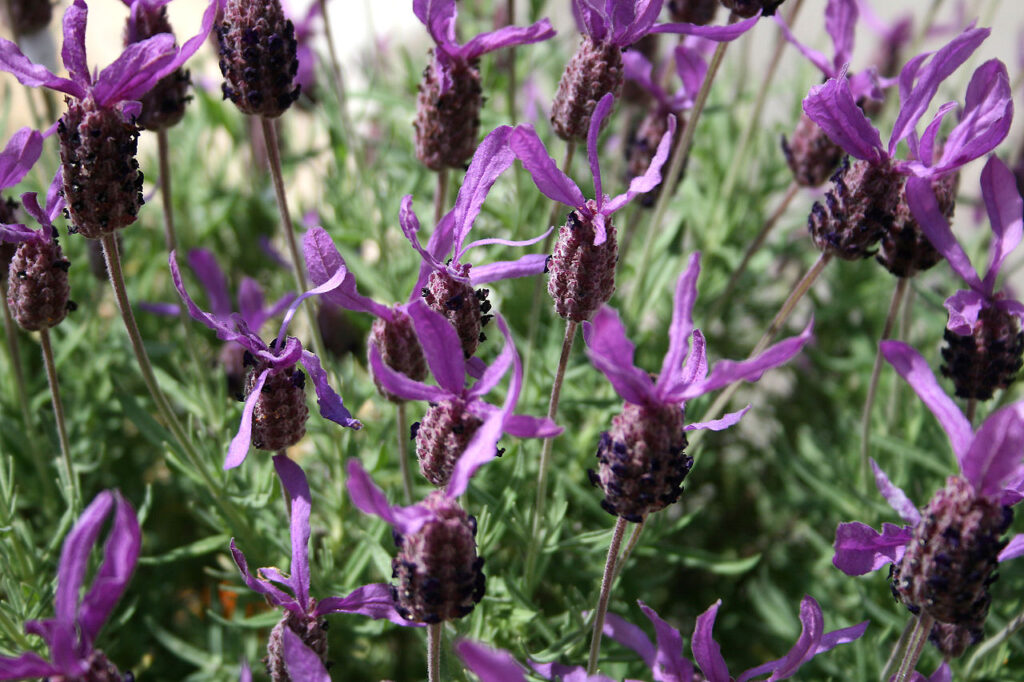Not everyone dreams of owning a sprawling lavender field. Then again, if a country estate in Provence landed in your lap, you probably wouldn’t complain. But let’s be real—not everyone has the space (or time) for a full lavender plantation. What most of us can manage, though, is tucking a few well-chosen plants into our landscapes or containers.
So, how do you decide which lavender variety is right for you? It comes down to your climate and what you’re looking for: fragrance, size, foliage, or hardiness. Let’s explore the options together.

Lavandula angustifolia (English Lavender)
When it comes to fragrance, this one reigns supreme. Hardy to about zone 5, English lavender is a versatile shrub that adapts well to most gardens. Its tidy flowers and colors—ranging from white and pink to soft lavender and rich purple—make it a classic choice for gardeners and perfumers alike.
Popular varieties include ‘Hidcote’ (a deep purple favorite), ‘Munstead’ (compact and reliable), and ‘Edelweiss’ (a lovely white). No wonder it’s the go-to for commercial perfume and dried lavender bouquets. The sweet aroma of this variety also makes it the best choice for culinary uses, as its flavor mirrors its fragrance in quality and softness.

For additional growing tips, consult the Royal Horticultural Society’s guide to lavender care.
Lavandula x intermedia (Lavandin)
If English lavender is the queen of fragrance, Lavandin might be the bold, slightly eccentric cousin. Its scent isn’t as fine, but it’s stronger, making it a standout in any garden. Hardy to zone 5 but slightly less cold-tolerant, Lavandin varieties also tend to be taller and boast striking silvery foliage.

Sterile hybrids like ‘Grosso,’ ‘Provence,’ and the aptly named ‘Phenomenal’ are popular choices. Their colors mirror those of English lavender, from white to pale lavender. These hybrids are propagated by cuttings, ensuring consistent quality from plant to plant.
Lavandula stoechas (Spanish Lavender)
Now we’re branching out a bit. Known as Spanish lavender (or sometimes French lavender—confusing, I know), this variety thrives in warmer climates and even grows as a weed in parts of Australia. Its fragrance isn’t as celebrated as our first two contenders, but it makes up for that with flashy, showy flowers that bloom quickly and in a rainbow of colors—including nearly red!

Hardy to about zone 6, it’s perfect for seasonal containers or adding a bold pop to the garden. For gardeners in cooler regions, overwintering it indoors or using containers can help extend its lifespan.
Lavandula dentata (Fringed Lavender)
If you’ve ever bought a lavender plant labeled as an annual herb, it was probably this one. Fringed lavender is tender but charming, with finely divided foliage that’s as decorative as the flowers. Its fragrance isn’t as memorable as English or Lavandin, but it still earns its place in herb gardens and planters.

Hardy only in warmer zones, it’s often treated as an annual in cooler climates. With a sunny windowsill and a little effort, though, it can be overwintered indoors.
More Lavender Varieties for the Curious Gardener
Feeling adventurous? Here are a few more lavender species and hybrids to try:
- Lavandula latifolia (Spike Lavender): Known for its intense camphor fragrance and broad leaves, it’s a bit of an acquired taste but worth exploring.
- Lavandula x chaytorae: This one steals the show with its extremely silvery foliage—absolutely gorgeous in any garden.
- Lavandula multifida: A fern-leafed lavender that’s easy to grow from seed and adds a delicate, airy texture.
For most gardeners, English lavender and Lavandin are the best choices for fragrance and flavor. On my farm, I’ve found that Lavandin varieties like ‘Phenomenal’ combine excellent hardiness and vigor with a fragrance that holds up beautifully in cold, wet winters. Regular pruning, taking care not to cut into old wood, keeps lavender plants productive and looking their best for years.
Growing Lavender: A Few Tips to Get Started
Choosing your lavender is just the first step. To help your plants thrive, check out my video on growing advice here: How to Grow Lavender.
And if you’re interested in propagating lavender, good news—it’s surprisingly easy! Watch this quick guide: Propagating Lavender.
For more information on lavender propagation and care, see this detailed guide from the University of Illinois Extension.
A Final Note
Whether you’re drawn to lavender for its fragrance, its flowers, or the calming aesthetic it brings to a garden, there’s a variety out there for you. Start small with a few plants, experiment with what grows best in your climate, and don’t be afraid to get your hands dirty with propagation.
Lavender isn’t just for sprawling fields in Provence—it’s for everyone who loves a little charm, fragrance, and beauty in their garden.





